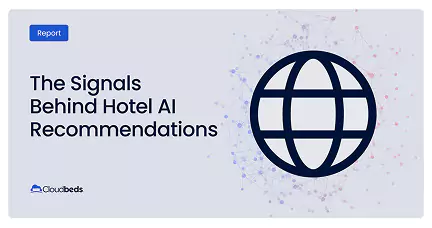Most travelers don’t book a hotel on their first visit to a website. Instead, they bounce between tabs, compare rates, and disappear without a trace. Failing to stay top-of-mind means you risk losing them to online travel agencies (OTAs) or competitors.
A key component of a hotel’s digital strategy, retargeting ads, re-engage high-intent travelers who have already expressed interest in your property. This enables teams to recoup revenue lost from cart abandonment and increase direct bookings.
In this article, we’ll explore how retargeting ads work, why they’re an essential part of your property’s digital strategy, and how to run successful campaigns that maximize revenue.
What are retargeting ads?
97% of visitors never return to complete their purchase upon leaving a website. Retargeting ads help with this by nurturing previously engaged travelers who have interacted with your website but didn’t complete a booking. It uses cookies to track and target these visitors, ensuring your brand stays top of mind even after they’ve left your site.
Retargeting displays personalized ads across various platforms, including Google’s ad network and thousands of partner websites. This reminds travelers of your property and encourages them to return.
The main goal of retargeting ads is visibility and views. It differs from other forms of paid advertising, including:
- Metasearch ads: Compete with online travel agencies (OTAs) for top rankings on metasearch sites like KAYAK and Google Hotel Ads
- Keyword ads: Attract new guests via search engines.
Retargeting vs. remarketing
While often used interchangeably, retargeting and remarketing actually serve different functions.
Retargeting refers to ad placements and display ads shown to visitors who have visited your website but did not complete a booking.
Remarketing focuses on re-engaging past guests through email, social media, and other promotional efforts.
Retargeting keeps your brand visible while remarketing encourages repeat visits. With both approaches working alongside one another, this creates a balanced digital strategy for hoteliers.
Core elements of a retargeting ad
Retargeting ads are relatively simple compared to other digital ad formats. They typically consist of just an image, a headline, and a short block of text—but their power lies in strategic execution, not complexity.
A successful retargeting ad is engaging, persuasive, and action-driven. It reignites your potential guests’ interest and provides a compelling reason for them to return to your website and book. This is achieved through four core elements:
- Strong visuals: High-quality images that capture your property’s ambiance and amenities.
- Compelling copy: Persuasive messaging that reinforces your property’s value and encourages direct booking.
- Optimized call-to-action (CTA): Clear, action-oriented phrasing such as “Book Now” or “Limited-Time Offer.”
- Mobile optimized format: Responsive, easy to read, and visually effective across devices and screen sizes.
Benefits of retargeting ads for hotels
There are many benefits to incorporating retargeting ads as part of your hotel’s marketing efforts. Retargeting ads help marketing and revenue managers create a more balanced hotel distribution strategy for their property, to attract the right audience on the right channel, at the right time.
Remarketing ads:
Drive direct bookings
Our 2025 State of Independent Lodging Report found that 61% of bookings are coming from online travel agencies, a 1.2% increase YOY. While OTAs are an essential part of a hotel’s marketing and distribution strategy, they shouldn’t be the dominant source of bookings.
Retargeting ads can help hotels recover some of this share by providing consistent follow-ups with high-intent visitors and recovering revenue once lost during the booking process. Instead of paying commissions to OTAs, hotels can redirect this budget into their own digital marketing strategies.
FREE REPORT
Discover regional OTA trends and other booking data.
Encourage brand recognition
Brand recognition is an equally important factor to keep in mind when marketing your hotel to potential guests. Retargeting ads strengthen brand recall by ensuring your property remains top-of-mind for travelers browsing.
Cost-effective
Retargeting ads are cost-effective and serve as an efficient tool for increasing conversion rates. Rather than target cold leads, retargeting aims to capture the attention of your warm leads, reminding returning visitors of your available room types, amenities, and features.
Support broader marketing efficiency
Retargeting doesn’t just stand on its own—it amplifies the effectiveness of your other marketing efforts. It captures value from traffic driven by SEO, metasearch, social media, and email campaigns, giving undecided visitors a second chance to convert. This extends the ROI of all your channels.
Provide strategic insights
Retargeting campaigns also generate valuable insights. The best-performing visuals, messaging, and offers can inform your broader marketing strategy, from email subject lines to on-site banners and paid search campaigns.
How to run effective retargeting campaigns
The success of your retargeting efforts depends on careful planning and execution. To maximize your campaigns, focus on guest segmentation, ad creativity, bidding strategy, and continuous optimization. Below are the key steps to running effective retargeting campaigns for your hotel.
1. Target the right travelers
A successful retargeting campaign starts with understanding how the targeting actually works behind the scenes.
When a traveler visits your hotel website or booking engine, a small piece of code—often referred to as a tracking pixel or retargeting script—places a cookie in their browser. This allows your ad platform to anonymously track that visitor and display your ads to them across a wide range of partner websites. These ads follow the traveler throughout their research journey, helping your property remain top-of-mind until they’re ready to book.
With this behavioral data, you can tailor your retargeting ads to match guest intent. For example, you might serve different messages to guests looking for weekend getaways versus longer stays, or to mobile users compared to desktop browsers.
2. Optimize ad creative
Optimizing your ad creative ensures your campaigns resonate and convert. Test your promotional messaging versus brand messaging. Match ad visuals with your booking engine experience to create a seamless transition to browsing visitors.
Remember, viewers of your retargeting ad will have engaged with your website before, so ensure your visuals and ad copy evoke a sense of familiarity, while remaining creative.
3. Adopt a strategic bidding strategy
Bidding plays a critical role in determining how often—and where—your retargeting ads appear online. Retargeting campaigns typically operate on a real-time bidding model, where your ad platform competes in auctions to show your ad. You can bid based on impressions (CPM) or clicks (CPC), depending on your goal.
Platforms like Google automatically enter your ads into auctions, and your bid amount, ad quality, and relevance score determine whether—and how frequently—your ad is shown. Even small changes in bidding strategy can impact your campaign’s performance.
Be sure to avoid short-term changes to your retargeting strategy. Give your campaign at least three months to gather meaningful data.
4. Ensure a seamless booking experience
Even the most well-executed retargeting campaigns can fall short if travelers encounter a slow or confusing booking experience. Ensure your booking engine is user-friendly, fast, and aligns with your brand identity for maximum conversions.
5. Analyze results and test
Once you’ve launched your retargeting ad campaigns, measure your ad’s performance to determine which aspects could be optimized better for improved results.
Many ad viewers will return to your website in other ways, so retargeting ads are primarily measured using impressions. Other key performance indicators to measure include:
- Click-through rate (CTR): CTR is 10x higher on retargeting ads than regular display ads. If CTR is low, test new images, messaging, and CTA wording.
- Conversion rate: If conversions are low, assess and improve your booking engine experience.
- Return on ad spend (ROAS): If ROAS is underperforming, adjust your budget and refine your audience targeting.
Continuously monitoring your growth and adjusting your retargeting campaigns will help refine your strategy and optimize for future ad performance.
Cloudbeds’ Digital Marketing: Retargeting built for hoteliers
Running high-ROI retargeting ad campaigns is simple with the Cloudbeds’ Digital Marketing. The solution simplifies the retargeting ad process with AI-enhanced ads, budget control, and real-time performance tracking, all within your PMS.
During Compass, Cloudbeds’ quarterly product webinar, Ben Lloyd, Director of Digital Marketing Services, shared how retargeting works within the platform.
Watch the full session from Compass.
Cloudbeds offers:
AI-enabled capabilities
Retargeting capabilities are directly integrated within the Cloudbeds platform, making it simple to manage your ads from one centralized location. AI-enabled ad campaign creation helps you generate and adjust your property images and messaging across your retargeting ads automatically.
Google ad network placements
Cloudbeds’ Digital Marketing also enables placements across Google’s ad network for your campaigns, including premium sites like the New York Times and Weather.com. This is in addition to more niche and country-specific websites.
The solution uses display ads dynamically created by Google to suit your available ad space and automatically optimizes to fit your best-performing ads.
Performance tracking and optimization
Cloudbeds offers a personalized dashboard to monitor and optimize key metrics such as ad views, clicks, conversions, and ROAS. With tracking scripts in place, you can accurately attribute bookings to your retargeting campaigns, ensuring data-driven optimization for any of your future ad strategies.
Advertisers can easily set and adjust budgets while monitoring revenue generated in real-time, providing greater insights and optimization capabilities to maximize campaign effectiveness.
Reengage guests and boost direct bookings
Retargeting ads give hotels the power to re-engage high-intent travelers and drive direct bookings. By targeting past visitors with compelling visuals, persuasive messaging, and strategic CTAs, you can turn abandoned bookings into confirmed stays.
Reclaim lost revenue with Cloudbeds.
Published on 8 April, 2025 | Updated on 2 September, 2025



